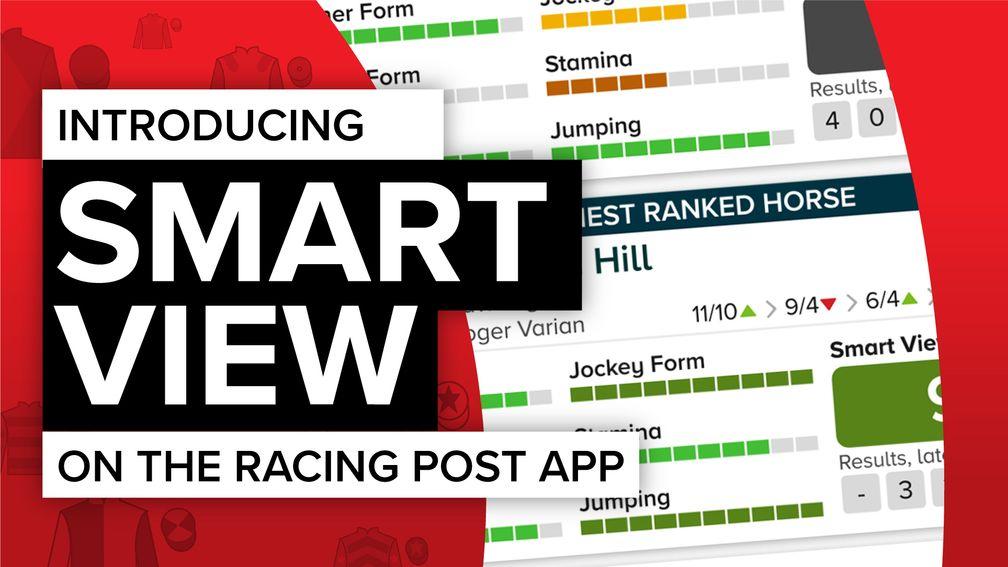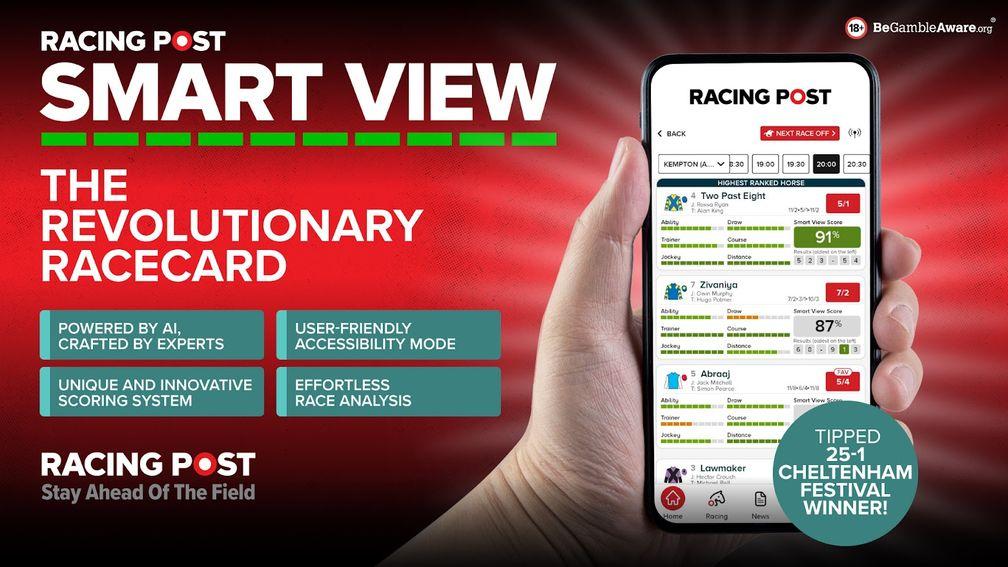- More
Smart View is available on the Racing Post app - how to read the revolutionary new racecard

What is Smart View?
Horseracing has a language of its own. Many of the idioms have made it into everyday English, so almost everyone grasps roughly what is meant by 'horses for courses' or 'a turn-up for the books'. But that is just the phrasebook. Over time, punters have created a whole dictionary on top.
For decades upon decades, the humble racecard has been the core text. Silks and names are easy enough to decipher, but is that person's name in bold the jockey or the trainer? And those numbers there are the form figures, right? What about that one in brackets? And what do you mean that's the compact version?
Racing Post's new Smart View card, which is available now only on the latest version of our mobile app – so make sure you have the most recent update, is a giant leap forward in how bettors read form. It carries out two main aims. The first is to break down the barrier to entry that many of the sport's prospective fans face with a traditional racecard. The second is to include in this stripped-back presentation everything that a serious punter would consider about a race.
The design has been user-led, with our research team carrying out hundreds of one-to-one interviews to test what is needed and wanted by our readers. The data aims have been shaped according to customer wishes and executed by a team of data scientists working with racing experts.
The result is the new Smart View card, which has been iterated towards over more than two years. It has been designed to need as little explanation as possible. But we also know that bettors are more curious than your average person, so here is more detail on how to read a Smart View racecard.
You will see a horse's silks, name, number, trainer, jockey, odds and form figures as before. The rest of the card is still there, contained in the six attribute bars. Each bar represents a score out of 100. The bars are colour-coded, in a traffic light-like system with bold green representing the best scores, but there is also an accessibility version so you can adjust your viewing experience to better suit your needs.
Every Smart View racecard entry includes a score for that horse's ability, trainer and jockey. The other three are made up from a list of five (course, distance, ground, draw and jumping), selected according to the race's code and other specific factors.
The Smart View attributes

Ability (1)
This metric starts from a horse's weight-adjusted Racing Post Rating. On top of the weight-adjusted RPR, certain conditions are added to allow either for a progressive horse's potential or to reflect the likely decline in a veteran. A machine learning algorithm determines the ability score in the most lightly raced horses.
Trainer (2)
Virtually all attributes have a base source, and for trainer and jockey this is their long-term record. Strike-rates are considered, as are big-race wins. The final tweaks to the trainer score come from their recent form, record at the track, and their record in similar races.
Jockey (3)
This follows similar methodology to trainer scores in the first instance. Jockey scores will also factor in their record for this trainer, and on this horse where appropriate.
Course (4)
Horses for courses in the 21st century. This score is based on more than form figures, as it draws on all performances by comparing a horse's RPRs at this track with those throughout their career. Where a horse lacks experience at today's course, the engine will look for runs at tracks with similar characteristics.
Draw (5)
Considers both historical and recent draw performance over the course and distance to assess how positive or otherwise today's draw might be. Field size and going are also folded into the data. Flat races only.
Distance (6)
Initially this measure takes a similar approach to course, weighing up a horse's record at today's trip against their career as a whole. It will also search recent in-running comments for clues. For example, a horse noted to have 'kept on well' over six furlongs last time would be expected to cope with seven furlongs today.
Ground (7)
The underlying philosophy on ground is the same as for course and distance. There are a few extra checks, such as considering when a horse has been pulled out on 'unsuitable' ground in the past. This attribute is dynamic, so any changes in the official going description will lead to a change in scores.
Jumping (8)
The cleverest attribute. The engine scans a horse's profile and picks up on not only falls and unseats, but also in-running notes like 'mistake third' and 'jumped well'. More forceful and more recent comments are given greater weight. Jumps races only.
Smart View Score (9)
The attribute bars all correspond to a score out of 100. These are turned into a weighted average to produce the overall Smart View Score. The exact weighting has been informed by machine learning, and will change according to the race type and conditions. While Smart View is much more than a tipping service, the top overall scorer is the engine's assessment of the horse with the most in their favour in this race.
Where is the seventh attribute?
There are eight attributes in all, seven relevant to Flat and seven to jumps. For now, the standard Smart View card displays only six of them. The other attribute is still calculated, but it is the engine that decides which six to consider. It does this by looking at the scores and omitting the one with the least impact in this race. Ability, trainer and jockey are exempt from this process, as testing told us that they were the most prized attributes.
In most but not all cases, the omitted attribute will be the one with the lowest range in the field. So if you are wondering where a certain attribute is, this will be why.
Having the system decide as much as possible was important to the design team. There was a final, slightly surprising, revelation from our research. Punters liked the idea of a system, rather than a human, being behind the scores. We have taken that as far as possible. We helped to train the engine, but now we leave it. The result is a product that is as infinitely useful and informative as the traditional racecard, but which leaves the betting decision in your hands.
How to find Smart View on your app

You will need to make sure you have the latest version of the Racing Post app. To do this search for 'Racing Post' on the Apple or Google Store.
Once your app is updated, click on your chosen racecard and select the Smart View tab as shown in the image above.
Read more like this:
How Smart View recorded a 76 per cent profit at the Cheltenham Festival

Introducing the new revolutionary Smart View racecard, powered by AI and crafted by experts. Take a look on the Racing Post app now
Published on inNews
Last updated
- Join Racing Post Members' Club for the very best in racing journalism - including Patrick Mullins' unmissable trip to see Gordon Elliott
- Racing Post Members' Club: 50% off your first three months
- Join the same team as Ryan Moore, Harry Cobden and other top jockeys with 50% off Racing Post Members' Club
- 'It’s really exciting we can connect Wentworth's story to Stubbs' - last chance to catch master painter's homecoming
- The jumps season is getting into full swing - and now is the perfect time to join Racing Post Members' Club with 50% off
- Join Racing Post Members' Club for the very best in racing journalism - including Patrick Mullins' unmissable trip to see Gordon Elliott
- Racing Post Members' Club: 50% off your first three months
- Join the same team as Ryan Moore, Harry Cobden and other top jockeys with 50% off Racing Post Members' Club
- 'It’s really exciting we can connect Wentworth's story to Stubbs' - last chance to catch master painter's homecoming
- The jumps season is getting into full swing - and now is the perfect time to join Racing Post Members' Club with 50% off